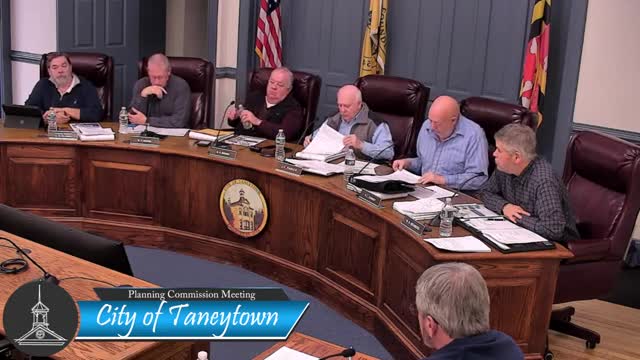Commission praises design of Mead's Crossing residential community during meeting
January 01, 2025 | Taneytown, Carroll County, Maryland
This article was created by AI summarizing key points discussed. AI makes mistakes, so for full details and context, please refer to the video of the full meeting. Please report any errors so we can fix them. Report an error »

The Planning Commission Meeting held on January 1, 2025, in Taneytown, Maryland, focused on several key topics, including the development of Mead's Crossing and discussions surrounding land use regulations. The meeting highlighted the commission's ongoing efforts to address community development and housing density issues.
One of the most significant discussions centered on Mead's Crossing, a residential development that has faced scrutiny in the past. A commission member acknowledged the project's design, noting the thoughtful integration of townhomes and single-family homes within the community. The member praised the layout, which features a mix of housing types on the same streets, allowing for a more cohesive neighborhood feel. This positive feedback marks a shift in the commission's perspective, recognizing the efforts made by developers to create a balanced community.
Another critical topic addressed was the calculation of housing density in relation to non-buildable land. The commission discussed the current code, which uses gross acreage to determine the number of lots that can be built, regardless of land that is not suitable for development, such as floodplains or steep slopes. This approach has raised questions about whether it adequately reflects the realities of land use. A suggestion was made to consider a net density calculation, which would only account for land that can be developed. This change could lead to more accurate assessments of housing capacity and better planning outcomes.
The meeting concluded with an invitation for community members to engage more actively in future discussions. The commission expressed a desire for increased public participation, encouraging residents and business owners to voice their opinions and feedback.
As the commission prepares for its next meeting on February 24, 2025, the discussions from this session underscore the importance of thoughtful planning and community involvement in shaping Taneytown's future development. The outcomes of these discussions may influence future policies and regulations, particularly regarding housing density and land use, as the town continues to grow and evolve.
One of the most significant discussions centered on Mead's Crossing, a residential development that has faced scrutiny in the past. A commission member acknowledged the project's design, noting the thoughtful integration of townhomes and single-family homes within the community. The member praised the layout, which features a mix of housing types on the same streets, allowing for a more cohesive neighborhood feel. This positive feedback marks a shift in the commission's perspective, recognizing the efforts made by developers to create a balanced community.
Another critical topic addressed was the calculation of housing density in relation to non-buildable land. The commission discussed the current code, which uses gross acreage to determine the number of lots that can be built, regardless of land that is not suitable for development, such as floodplains or steep slopes. This approach has raised questions about whether it adequately reflects the realities of land use. A suggestion was made to consider a net density calculation, which would only account for land that can be developed. This change could lead to more accurate assessments of housing capacity and better planning outcomes.
The meeting concluded with an invitation for community members to engage more actively in future discussions. The commission expressed a desire for increased public participation, encouraging residents and business owners to voice their opinions and feedback.
As the commission prepares for its next meeting on February 24, 2025, the discussions from this session underscore the importance of thoughtful planning and community involvement in shaping Taneytown's future development. The outcomes of these discussions may influence future policies and regulations, particularly regarding housing density and land use, as the town continues to grow and evolve.
View full meeting
This article is based on a recent meeting—watch the full video and explore the complete transcript for deeper insights into the discussion.
View full meeting
